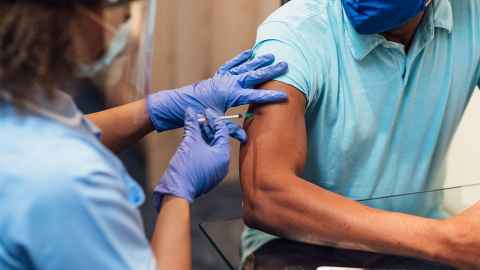Why Māori and Pacific people should get the vaccine first
17 February 2021
Opinion: With much higher rates of Covid infection and death, Māori and Pacific people should be first in line for the vaccine, write Collin Tukuitonga and Grace Shaw.

Pacific and Māori people must be prioritised for Covid-19 vaccination along with other high-risk groups in Aotearoa New Zealand.
The reason? Because studies have shown Pacific and Māori people have an increased risk of Covid-19 infection, hospitalisation, and death. This heightened risk of Covid-19 reflects the fact that these same communities are also more vulnerable to infectious diseases including acute rheumatic fever, tuberculosis, and many other viral diseases.
The first wave of Covid-19 cases in Aotearoa New Zealand in 2020 were reported mainly in non-Pacific, non-Māori (mostly European) people who had returned from overseas travel. However, the second wave reported in Auckland in August 2020 affected mainly Pacific and Māori people as the cases were transmitted in households, workplaces and churches. Two thirds of all cases were reported in Pacific people.
One study found that non-Pacific, non-Māori (mostly European) people aged 80 years had similar risk of developing a clinically severe infection as Pacific people aged 55 years. Additionally, Pacific people have a three times greater risk of hospitalisation due to Covid-19 than non-Pacific, non-Māori people.
Increased risk of Covid-19 infection, hospitalisation and death among Pacific and Māori people reflects the prevalence of pre-existing comorbidities such as obesity, diabetes, asthma and heart disease. These non-communicable diseases disproportionately affect Pacific and Māori people in New Zealand. For example, in the 2019/2020 New Zealand Health Survey, 63 percent of Pacific adults were obese compared with 48 percent of Māori and 29 percent of non-Pacific, non-Māori people. Furthermore, 15 percent of Pacific adults have type 2 diabetes compared to five percent of non-Pacific, non-Māori people.
The increased risk of Covid-19 in these populations is not only due to these pre-existing health conditions but also existing structural inequities such as overcrowding, multigenerational households, substandard housing, increased difficulty accessing healthcare, and higher levels of deprivation. Crowded housing in Pacific communities can increase the spread of Covid-19 rapidly, with 40 percent of Pacific people living in overcrowded households.
History already tells a story of the risk pandemics pose to these communities. In the 1918 Influenza pandemic, the death rate for Māori was more than seven times the European rate. In the Pacific, its effects varied greatly across different populations. In Samoa, it killed 22 percent of the population in that country.
In the 1957 pandemic, the Māori death rate was more than six times the European rate.
More recently, in the 2009 influenza pandemic, the Pacific death rate was nearly six times higher than that for other New Zealanders. The Māori death rate was two and half times higher than the European rate; Māori notification rates were twice the rate of Europeans; Pacific notification rates were four times that of Europeans.
In late 2019, the Samoan Ministry of Health declared a measles outbreak and by January 2020, 5,707 measles cases and 83 measles-related deaths were reported. Almost all the deaths (87 percent) were in children below the age of five. It is thought the epidemic originated in Aotearoa/New Zealand.
The occurrence of Covid-19 cases anywhere in the community presents a risk to all New Zealanders. Nobody is safe until this disease is ‘eliminated’ in line with the overall national plan and strategy. This is why protecting all our high-risk communities must be a priority.
Dr Collin Tukuitonga is the Associate Dean Pacific at the Faculty of Medical and Health Sciences and Grace Shaw is a masters student from the University of Otago on a public health attachment to the faculty.
This article reflects the opinion of the authors and not necessarily the views of the University of Auckland.
Used with permission from Why Māori and Pacific people should get the vaccine first 17 February 2021.
Media queries
Alison Sims | Research Communications Editor
DDI 09 923 4953
Mob 021 249 0089
Email alison.sims@auckland.ac.nz